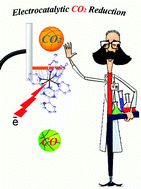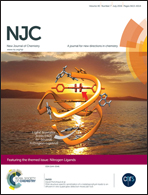Electrocatalytic reduction of CO2 to CO by a mononuclear ruthenium(ii) complex†
Abstract
A new mononuclear ruthenium(II) complex, [Ru(dmbpy)(tptz)(Cl)](PF6) (where dmbpy = 4,4′-dimethyl-2,2′-bipyridine and tptz = 2,4,6-tris(2-pyridyl)-1,3,5-triazine), has been prepared and characterized by spectroscopic methods, cyclic voltammetry (CV), and single-crystal X-ray crystallography. The electrocatalytic activity of the Ru(II) complex was investigated for the reduction of CO2 to CO in acetonitrile by cyclic voltammetry under different reaction conditions including temperature variation, CO2 concentration, catalyst concentration, and the scan rate. A detailed mechanism for the electrocatalytic reduction of CO2 to CO by the Ru(II) complex has been investigated in the gas and solution phases using DFT calculations. These calculations indicate that the first catalytic step involves two sequential one-electron ligand-based reductions, followed by a CO2 coordination reaction and a concerted two-electron transfer from tptz2− to the coordinated CO2 ligand to give a metallocarboxylate intermediate (Ru–CO22−). The HOMO and LUMO of this intermediate are still polypyridyl-based and the next two electrons enter molecular orbitals with tptz- and dmb-character. These two one-electron reductions result in the formation of an intermediate which can be targeted by free CO2 to release a CO molecule. The calculations provide detailed mechanistic information in agreement with the experimental results.


 Please wait while we load your content...
Please wait while we load your content...